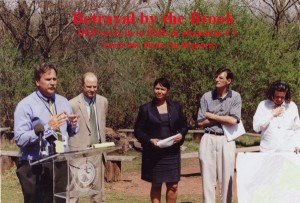DEP Abandoned Wood Turtle Habitat Protections

[Update below]
Unless you closely follow the technical discussion on the NJ Highlands email listserve, you probably don’t know that DEP abandoned a key regulatory tool to protect critical habitat of the State threatened species, Wood Turtle.
There were no press conferences, action alerts, sign on letters or other forms of protest by environmental groups. Yes, if one knew where to look, one could find some mention opposing this rollback by reading the fine print of written comments formally submitted to DEP on the rule proposal by a few conservation groups with biological expertise. But no major political or media opposition was mounted.
As a result, there was no press coverage to alert the public and no accountability for the DEP politicians who did this vile deed.

Earth Day, 2007 – environmentalist applaud DEP rollbacks
In fact, you might have just the opposite impression, because the DEP rule proposal that abandoned protections for the wood turtle – and countless other species – was SUPPORTED by environmental groups. It received VERY FAVORABLE press coverage.
This occurred, despite a January 2007 warning letter signed by numerous groups, strongly urging DEP Commissioner NOT to make the regulatory change to current regulations that can be used to protect wood turtle habitat. Here is the intro – read the whole letter:
Dear Commissioner Jackson:
In a late December meeting attended by many of our groups, the Department outlined its plan for a new process to guide the designation of Category One waterways. The meeting afforded only a cursory overview of what would represent a very fundamental change to clean water protections in New Jersey, but did provide an outline of the narrow set of water quality indicators that might serve as the basis for deciding future C1 upgrades. We have serious objections to the proposed designation process and fear that its implementation would strip New Jersey of the ability to adequately protect and maintain its high quality waterways. If enacted, this method would reverse tremendous advances in clean water protection in the state, contradict the commitments made by Governor Corzine, and leave New Jersey without the ability to adequately protect and maintain many of its most deserving waterways.
Signed: Jeff Tittel, Sierra Club, NJEF, ANJEC, Environment NJ, et al
Say What? Here’s that sad tale:
Wood turtles are semi-aquatic turtles preferring clear, well-oxygenated streams surrounded by a mosaic of woodlands, scrub-shrub/herbaceous wetlands, and successional meadows. In New Jersey, the wood turtle is commonly associated with water-quality sensitive fish such as native brook trout and brown trout.
While once ubiquitous throughout northern New Jersey, most of the viable wood turtle populations remain in rural portions of Sussex and Warren counties.
Degraded water quality, habitat fragmentation, road mortality, and predation are the primary factors behind its extirpation from developed portions of the State. Observational evidence from the Passaic River suggests that siltation of streams, as a result of storm water discharge and urbanization of the surrounding land, can lead to a decline in turtle populations. (p. 19-20)
In order to protect the wood turtle and its critical habitat – as well as habitat for numerous aquatic or aquatic dependent species – in 2002, DEP strengthened and greatly expanded water quality regulations – known as “Category One” (C1) waters – to implement the “antidegradation policy” mandated by the federal Clean Water Act. Federal law requires states to adopt antidegradation policies and implementation procedures.
Anti-degradation policy seeks to assure that exceptional high quality waters are not degraded by pollution. For the first time, using anti-degradation legal tools, DEP gave these exceptional waters real regulatory protections, by providing 300 foot wide stream buffers (on each side), where soil and vegetation may not be disturbed by major development.
Starting in early 2002, DEP began to classify C1 streams and rivers based upon “exceptional value” ecosystems. DEP also began designating streams and rivers that drained to reservoirs to protect water supply.
Previously, this C1 classification was limited to a few hundred stream miles that supported naturally reproducing trout populations.
Yet, even despite the C1 designation, historically, those streams were unprotected by DEP regulations.
The result of the new DEP C1 policy was a huge expansion of over 2,000 designated C1 stream miles and – at 75 acres of stream buffer per mile – thousands of acres of riparian land in new protected C1 stream corridors.
These DEP regulatory moves were strongly opposed by the NJ Builders Association, pro-development industries, and property owners. Builders particularly opposed the new DEP policy of linking water quality and habitat, and using the “exceptional ecological significance” Clean Water Act policy tool to regulate development and land use to protect water quality.
The wood turtle became a poster child in this debate, because thousands of acres of land were classified as wood turtle critical habitat. Therefore, thousands of acres of such land located in stream corridors could be regulated and made off limits for development via DEP designation of C1 waters.
One key factor in determining “exceptional ecological significance”, was the presence of wood turtle or critical habitat. According to DEP’s new C1 designation methodology:
The stream’s ability to support water-dependent endangered and threatened species, such as bog turtle, wood turtle, long-tailed salamander and dwarf wedgemussel was a significant factor in determining whether a stream qualifies as a waterbody of “exceptional ecological significance”. (page 9) (link here)
Between 2002-2003, the following exceptional streams were designated C1 protected on the basis of the presence of wood turtles and/or critical habitat – each designation protected lands in stream buffers. These regulatory moves by DEP triggered major battles with the builders because they blocked large development projects:
- In November 18, 2002: Assiscunk Creek; Beaver Brook; Flat Brook; Sidney Brook; South Branch Rockaway Creek;
- In January 6, 2003: Paulins Kill;
- In November 3, 2003: Harihokake Creek; Nishisakawick Creek; Pohatcong Creek; Wickecheoke Creek; Plum Brook;
(I really wish DEP would stop killing these links! Just restored- the links 4/13/16 to above 3 C1 proposals).
Under the new pro-economic development Corzine/Jackson DEP, the legal ability of DEP to designate C1 streams on the basis of wood turtle – and numerous other threatened and endangered species – was lost by DEP in a May 21, 2007 rule proposal where DEP revised the C1 designation methodology.
The revisions greatly narrowed DEP’s ability to designate C1 waters and eliminated wood turtle as a basis for doing so.
The Lisa Jackson DEP found that a new method was required as a result of “experience” – read the code for “due to strong oppostion by the powerful development community“:
Based upon the experience gained in the review and analysis of waterbodies for potential Category One designation, the Department is proposing to establish new definitions. These new definitions better define the data and criteria utilized to identify waterbodies that qualify for consideration for upgrade to Category One designation. These definitions are data driven and will better serve to identify waters that are truly exceptional. The Department is proposing amendments to the definition of “category one waters” and introducing new definitions for “Exceptional Ecological Significance”, “Exceptional Fisheries Resource(s)”, “Exceptional Water Supply Significance”, and “HUC 14″. (page 5) (link)
The new DEP C1 designation method limited exceptional ecological value to a short list of specific species – if a species was not listed, it was not protected. The list did NOT include wood turtle.
Exceptional Ecological Significance – Endangered or Threatened Species (E&T)
The Department is now proposing that a waterbody with the presence of suitable habitat verified by the Department to support Bog Turtle, Dwarf Wedgemussel, Brook Floater, Triangle Floater, Green Floater, Eastern Pondmussel, or Eastern Lampmussel, with a documented occurrence(s) of at least one of these species verified by the Department are eligible for consideration for Category One antidegradation designation upgrade. To qualify for consideration for Category One status as a waterbody of exceptional ecological significance, requires that the waterbody have suitable habitat verified by the Department to support on of these aquatic dependent E&T species and documented occurrence(s) verified by the Department. These species include several freshwater mussels and Bog Turtle. … (page 7)
For a detailed description of each species and its habitat see this link:
For the wood turtle, the fight for riparian habitat protections is over – DEP unilaterally surrendered.
The only protections remaining are case by case, site specific mitigation in individual land use permits – a formula for extirpation.
End of story.
[10/4/09 Update – Brian Murray of the Star Ledger picked up on the pine snake story today: Frustrated developers are hissing back at a snake
A colleague advised that the NJ Builders Association recently filed a petition for rulemaking urging DEP to delist pine snake and eliminate certain site specific regulatory protections for its habitat.
This reminded me of the sorry tale of loss of DEP protections for the wood turtle – and countless other species. Old news. ~~~ end update]

 At a Trenton State House news conference today, Independent
At a Trenton State House news conference today, Independent 




